Test geek and founder of Aptitude-Test-Prep.com
What Is the PI Cognitive Assessment?
The Predictive Index (PI) cognitive assessment is a pre-employment cognitive ability test, designed to measure a candidate’s ability to acquire new knowledge. The test will always be accompanied by the PI Behavioral Assessment.
Similar to many other cognitive ability tests, the main challenge of the PI Cognitive Assessment is the short time span given to solve questions – 50 questions in 12 minutes, an average of 15 seconds per question.
However, using the solid 40% Extra Time Technique, that number can reach around 25 seconds.
In the Free Practice section, you will find a full-length PI mock test. Combine it with the PI Scoring Guide in the Scoring section to know how you compare with your required PI Job Target Score.
Finally, learn how to GET that score in the Preparation section.
Test Structure and Question Format
The PI Cognitive Assessment (PICA) is a standard multiple-choice test that contains 9 question types over 3 categories:
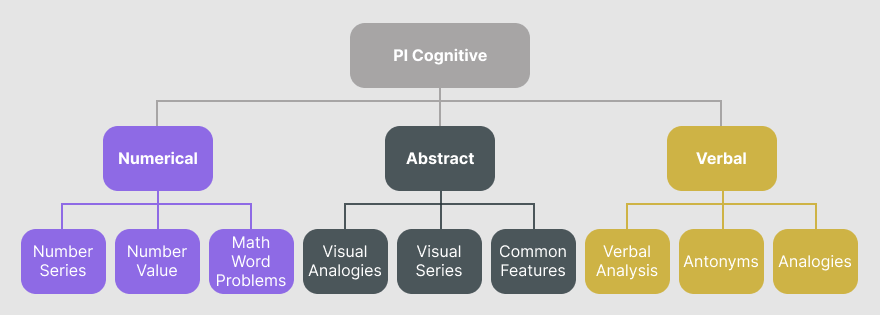
Question topics and types will constantly change in order to assess your ability to “shift” your mindset, a common feature in cognitive ability tests that is also used in the classic Thurstone Test.
Here is a brief overview of all 9 PI question types, including one sample question for each.
All sample questions below were taken from the Free Practice. Answers and explanations are given in the Answers section.
Numerical
Number Series
A sequence of numbers following a mathematical pattern. You are required to choose the right number to complete the pattern.
Show Sample Question
What is the next number in the sequence below?
7, 2, 10, 13, 24
- 33
- 37
- 38
- 41
Number Value
This type of question is unique to the PI test. You need to choose the number that has the lowest value out of 4 options.
Show Sample Question
Which number has the lowest value?
- 2/9
- 2/3 – 4/9
- 15
- 1/3
Math Word Problems
Simple word problems covering basic math operations, averages, and percentages.
Show Sample Question
Four students have an average score of 86. A fifth student joined the class with a score of 96. What will be the new average?
- 87
- 88
- 5
- 5
Abstract
Visual Analogies
You are given a pair of shapes that have a certain relationship. You need to choose the shape that follows the same relationship with a third shape.
Visual Series
You are presented with a sequence of shapes. These shapes follow a certain pattern leading from one shape to the next. You need to choose the shape that correctly continues the pattern.
Common Features
You are presented with two shapes sharing a common feature. You then need to choose the shape that does not share the same feature out of 4 given options.
Verbal
Antonyms
You will need to find the word whose meaning is the opposite of a given word.
Show Sample Question
Which of the following is the opposite word of ‘complex?
- compound
- diverse
- elementary
- false
Analogies
You are given a pair of words that have a certain relationship. You need to choose the word that follows the same relationship with a third word.
Show Sample Question
Wind is to air as stream is to
- river
- water
- breeze
- flow
Verbal Analysis
You are presented with several assumptions you should regard as true. Based on these assumptions, you should decide whether a given conclusion is correct, incorrect, or that it cannot be determined based on the given information.
Show Sample Question
Assumptions:
- Company A and Company B produce products X and Y.
- Product Z is never produced by companies that produce product X.
Conclusion:
- Product Z is never produced by companies A and B.
If the assumptions are true, is the conclusion:
- Correct
- Incorrect
- Cannot be determined based on the information available.
Note that the name “Professional Learning Indicator (PLI) is an older name of the current PICA, and they both refer to the same test.
PI Cognitive Assessment Test Preparation
We strongly recommend JobTestPrep’s PI Cognitive Test Preparation.
- Accurate, authentic practice tests
- A comprehensive learning process
- Additional prep for the Behavioral Assessment
- A money-back guarantee policy
What Do You Get?
- PI Cognitive Diagnostic Test with personalized feedback
- 5 Full PI Cognitive Simulations
- 43 PI Cognitive Practice Tests of all question types: Numerical, Verbal, Abstract/Visual
- 11 Study Guides & Video Tutorials
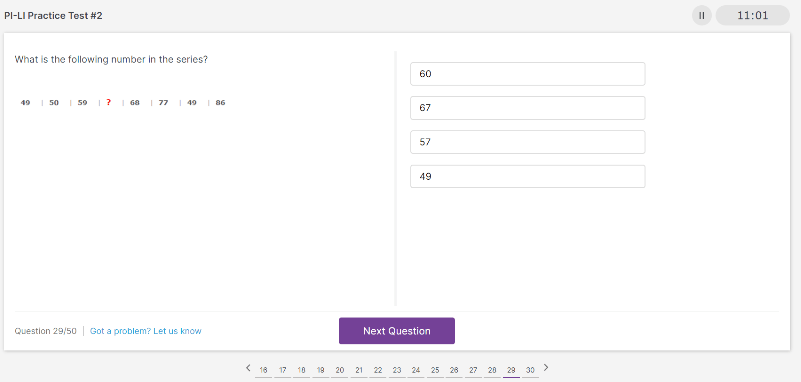
Full Disclosure: We are affiliated with JobTestPrep. Clicking the links helps us provide you with high-quality, ad-free content.
PI Cognitive Random Question Selection
One of the unique features of the PI Cognitive test is the question selection mechanism. Questions are randomly selected from a pool of 315 items, around 30-50 for each question type.
That method is known as LOFT (linear-on-the-fly testing).
LOFT method helps PI create tests that are, on one hand, equal in difficulty for all test-takers, and on the other hand, give each candidate a unique test version.
However, while the number of combinations is virtually infinite, the number of ITEMS is not that big.
30-50 questions per topic is definitely something you can cover in several days of practice, and while you may not improve in solving ALL possible questions that may come up, you certainly can get closer.
Head over to the PI Cognitive Free Practice Test, or start preparing.
Test Interface
PI Cognitive Test Invitation Email
Your journey with the PI test starts with your test invitation, that looks something like this:

After you follow the link you enter PI’s testing website, where you will read the instructions and solve a few sample questions (only 3 of the 9 types).
Test Instructions and Technical Details
Before the actual assessment, you will be shown several basic instructions by PI:
- You must complete the test in one sitting.
- PI recommends taking the test on a computer and not a mobile device.
- No points are reduced for wrong answers.
- The use of calculators is not allowed.
Once you are done with the instructions and samples, you will take the assessment.
The PI Cognitive Test Screen
Generally, this is how your PI test screen is going to look like:

- There will be 10 screens, each containing 5 questions.
- The top bar will track the number of pages completed.
- You will be able to track the time in minutes only (not seconds).
- Each question will have 4 answer options (except for Verbal Analysis with 3 answer options).
- You can move back and forth between pages.
- You do not have to complete all questions on a page to move on to the next.
PI Cognitive Assessment Test Preparation
We strongly recommend JobTestPrep’s PI Cognitive Test Preparation.
- Accurate, authentic practice tests
- A comprehensive learning process
- Additional prep for the Behavioral Assessment
- A money-back guarantee policy
What Do You Get?
- PI Cognitive Diagnostic Test with personalized feedback
- 5 Full PI Cognitive Simulations
- 43 PI Cognitive Practice Tests of all question types: Numerical, Verbal, Abstract/Visual
- 11 Study Guides & Video Tutorials

Full Disclosure: We are affiliated with JobTestPrep. Clicking the links helps us provide you with high-quality, ad-free content.
Free PI Cognitive Assessment Practice
This free practice test is an authentic PI Cognitive Assessment mock test. It contains 50 questions covering all 9 PI question types.
Timing is crucial, so set a timer for 12 minutes and STOP when the time is up. You may use the printable PDF answer sheet and answer key.
All answers and explanations can be found in the Answers section.
Good luck!
Pro Tip
Once completing the test, you will be able to know how you compare with your PI Job Target Score through the PI Scoring Guide in the Scoring section.
Assumptions:
- All Type C clocks are square.
- Square clocks are not valuable.
- Some Type D clocks are the same shape as Type C clocks.
Conclusion:
Some Type D clocks are not valuable.
If the assumptions are true, is the conclusion:
- Correct
- Incorrect
- Cannot be determined based on the information available.
Which number has the lowest value?
- 1/3
- 2/3 – 1/6
- 1/3 – 1/9
- 1/9
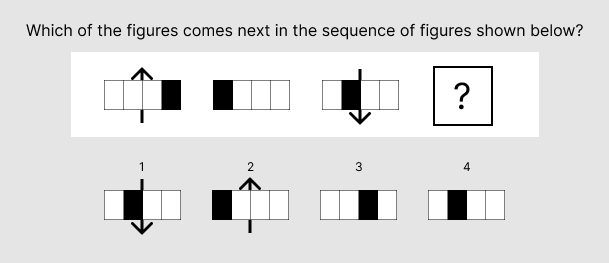
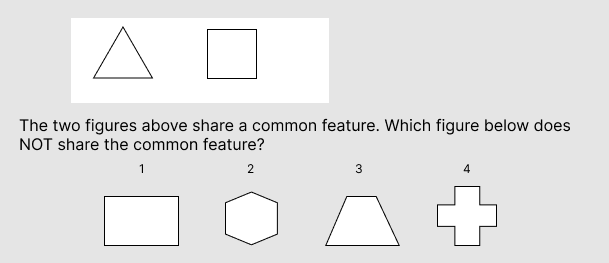
Jam is to jar as salt to
- bar
- bag
- cup
- sugar
Which of the following is the opposite of the word “hard-working”?
- tired
- meticulous
- idle
- done
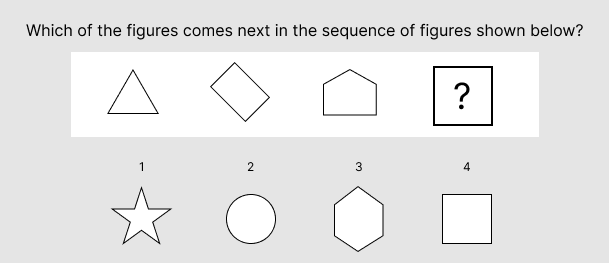
What is the next number in the sequence below?
6, 13, 27, 55
- 110
- 111
- 152
- 82
You have 6,000 products in your warehouse. You must deliver 20% of them in four days. If you plan to deliver the same number of products every day, how many products will you send per day?
- 1500
- 300
- 150
- 75
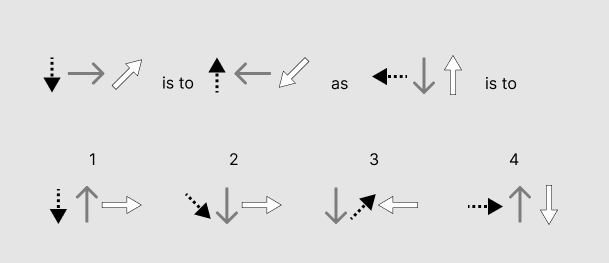
Assumptions:
- Company A and Company B produce products X and Y.
- Product Z is never produced by companies that produce product X.
Conclusion:
- Product Z is never produced by companies A and B.
If the assumptions are true, is the conclusion:
- Correct
- Incorrect
- Cannot be determined based on the information available.
What is the next number in the sequence below?
11, 14, 18, 23, 29
- 37
- 34
- 32
- 36
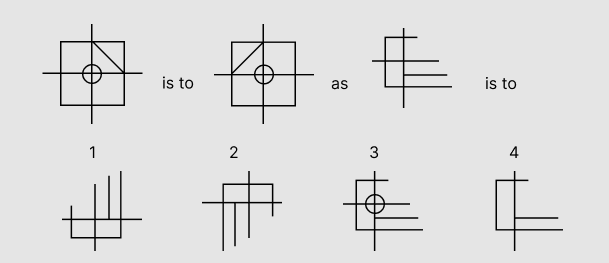

87 tasks have been assigned to you and your team. On Monday, you completed 13 tasks. On Tuesday you completed 22 tasks. On Wednesday you completed 18 tasks, and on Thursday you completed 25 tasks. Today is Friday morning. How many tasks remain?
- 14
- 7
- 9
- 11
Which of the following numbers has the lowest value?
- 0.2
- 1/4
- 0.5 – 1/5
- 3/5
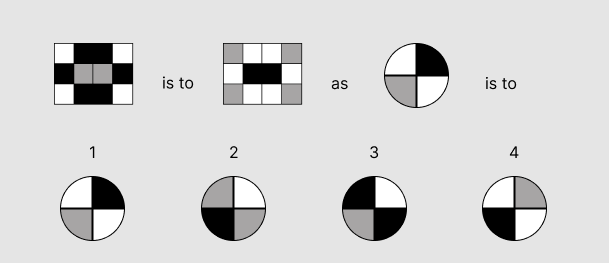
Which of the following is the opposite of the word “definite”?
- uncertain
- weak
- clea
- quiet
Weak is to power as despaired is to
- might
- hope
- truth
- fairness

What is the next number in the sequence below?
7, 2, 10, 13, 24
- 33
- 37
- 38
- 41
Which of the following is the opposite of the word ‘reckless’?
- bold
- cautious
- dangerous
- foolish
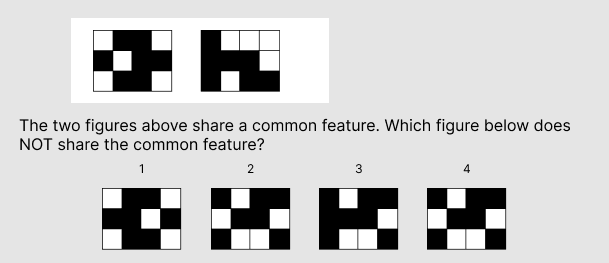

What is the next number in the sequence below?
-2, 3, -4, 5, -6
- -7
- 7
- -5
- 8
Author is to book as composer is to
- symphony
- video
- sculpture
- performance
Which number has the lowest value?
- 4/3
- 7/6
- 9/8
- 10/9
Assumptions:
- All employees in Store 1 attend the sales conference.
- Some employees in Store 1 attend the marketing conference. Some employees who attend both conferences are in Store 2.
Conclusion:
- All employees who attend the sales conference and also attend the marketing conference are in Store 1.
If the assumptions are true, is the conclusion:
- Correct
- Incorrect
- Cannot be determined based on the information available.
If 20 plates cost as much as 30 cups, how many cups could you buy for the price of 14 plates?
- 28
- 10
- 24
- 21
Assumptions:
- Some managers from the main branch work in New York and the rest work in Boston.
- Managers from various branches work in Boston.
Conclusion:
- Some managers from the main branch work in the same city as managers from other branches.
If the assumptions are true, is the conclusion:
- Correct
- Incorrect
- Cannot be determined based on the information available.
What is the next number in the sequence below?
4, 5, 7, 11
- 13
- 15
- 17
- 19
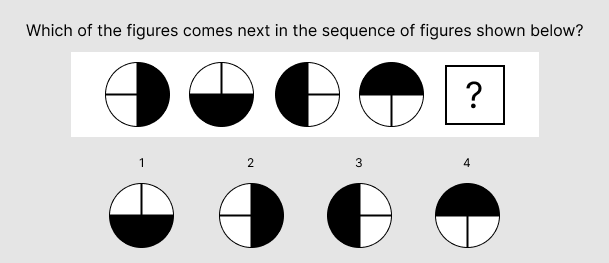
Which of the following is the opposite of the word “pricey”?
- expensive
- cheap
- valuable
- negligible
If 6 cars take 15 days to make, how many days does it take to make 8 cars?
- 20
- 5
- 5
- 18

You are a member of a QA team of 12 members. Each quality assurance test takes approximately 15 minutes for any team member to complete. The team is missing 4 members. If you have 640 tests to perform, how many hours will each team member work?
- 30 hours
- 25 hours
- 20 hours
- 15 hours
Word is to letter as sentence is to
- word
- paragraph
- text
- read
Andy has 12 marbles more than Bob. Bob has 6 marbles more than Chris. Andy has 36 marbles. How many marbles does Chris have?
- 18
- 6
- 36
- 24
Which of the following is the opposite word of ‘gentleman?
- rodent
- rascal
- snake
- orbit
Assumptions:
- There is no manager that did not attend the sales workshop.
- Everyone who has attended the sales workshop is an outstanding employee.
Conclusion:
- All managers are outstanding employees.
If the assumptions are true, is the conclusion:
- Correct
- Incorrect
- Cannot be determined based on the information available.
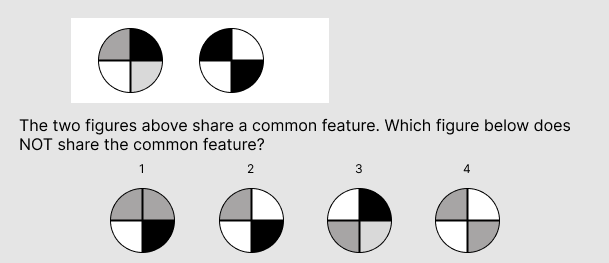

Which number has the lowest value?
- 1/2 – 1/6
- 1 – 1/8
- 1/4 – 1/5
- 1/3 – 1/7
Wine is to grapes as flour is to
- sugar
- bread
- earth
- wheat
What is the next number in the sequence below?
1, 4, 9, 16, 25
- 34
- 36
- 40
- 52
Wind is to air as stream is to
- river
- water
- breeze
- flow
What is the next number in the sequence below?
12, 15, 20, 28, 41
- 56
- 58
- 66
- 62
Which of the following is the opposite word of ‘complex?
- compound
- diverse
- elementary
- false
Which number has the lowest value?
- 2/9
- 2/3 – 4/9
- 15
- 1/3
Four students have an average score of 86. A fifth student joined the class with a score of 96. What will be the new average?
- 87
- 88
- 5
- 5
The PI Scoring Guide, or The 40% Extra Time Technique
This guide is going to give you a step-by-step process to:
- Take your raw score from the Free PI Test and find your PI test score and percentile.
- Compare your PI Cognitive score with your required Job Target Score (the score you need for a perfect cognitive match).
- Learn the PI preparation and test-taking technique to give you 40% more solving time.
- Now that you have your desired score, we highly recommend using JobTestPrep’s accurate PI Cognitive prep course to get it. Read more about it in the Preparation section.
We hope to give you a realistic image on what type of preparation you need, if any.
The 5 steps are:
- Calculate Job Target Score.
- Job Target Score modification (+30).
- Find your PI cognitive score.
- Compare
- Lower the Number of Questions to Solve.
Step #1 – Calculate Basic Job Target Score Table
Before you even start the assessment, the employer defines a Cognitive Job Target – namely, a cognitive PI score required for the job. That is a number on a PI internal scale of 100-450.
The following table presents the predefined Job Scale Scores for a variety of professions:
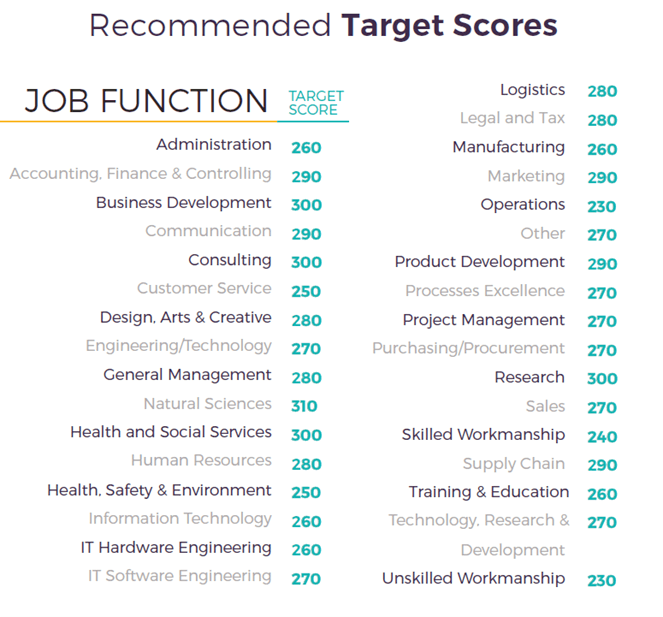
Source.
Practical Example – Step #1:
John needs to take a PI Cognitive Assessment for the role of a VP.
According to the Job Target Scores Table, the required score for a candidate in general management is 280.
Step #2 – Job Target Score Modification
The employer may or may not increase or decrease the Cognitive Job Target Score by up to 30 points, depending on the requirements of the specific position.
To be on the safe side, always assume that this modification is +30.
Practical Example – Step #2:
We’ll add 30 points to the basic score John needs – 310.
Should I Pass My Modified Job Target Score?
TL;DR – It is naturally best to aim as high as you can. However, you should know that this extra effort will likely have no effect on your chances with the employer.
Why?
The PI test’s scoring method dictates that if your employer has set a Job Target Score of, say, 300, both a candidate with a score of 300 and a candidate with a score of 400 will be marked as a perfect cognitive match for the job.
What will determine which of them is selected are their PI Behavioral Test scores.
Employers CAN, if they wish, take a deeper dive into your test scores and see your percentile and section scores, but PI actively discourages them from doing so, and recommends relying mainly on PI Behavioral test scores to make a decision.
This is how the employer sees PI Cognitive scores when comparing candidates. Look closely at candidates 1 and 2:

Source.
As you can see from the bell curve, candidate 2 has a MUCH higher cognitive test score than candidate 1, but both got a perfect 10 cognitive match score. And, due to a very low behavioral match score, candidate 2 is likely to be disqualified.
Step #3 – Convert Your Raw PI Cognitive Score to the PI Scaled Score
Use the following table to convert your raw score in the full-length, 50-question Free Test to the PI’s 100-450 scale.
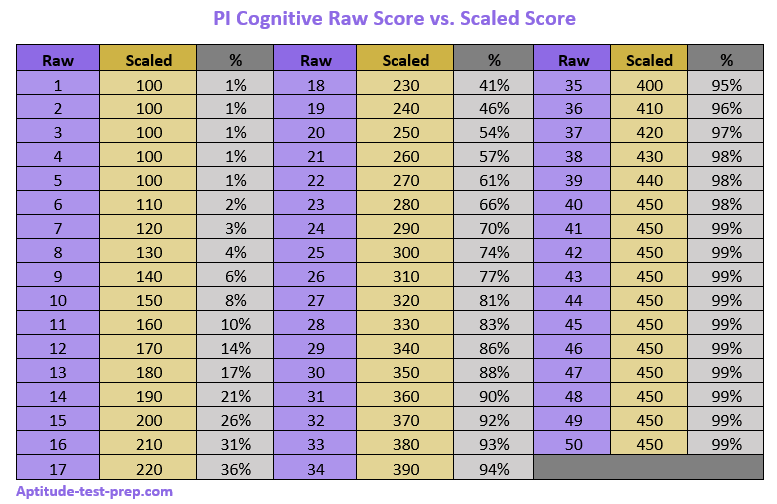
Source.
Pro Tip
As you can see, scoring 40 out of 50 questions will put you on the top 2% of scorers. So, when someone tells you that “it’s an average of 15 seconds per question”, that’s really not the case.
It’s actually 18 seconds per question.
And actually-actually, it’s probably closer to 25, as you’ll soon see.
Practical Example – Step #3:
Let’s say John has answered 20 questions correctly on the Free PI Sample Test, which is about the average score. According to the Score Conversion Table, that is a scaled score of 250.
Step #4 – Compare
Compare your score with the Job Target Score.
This is how your employer is going to see it when taking a closer look into your profile:
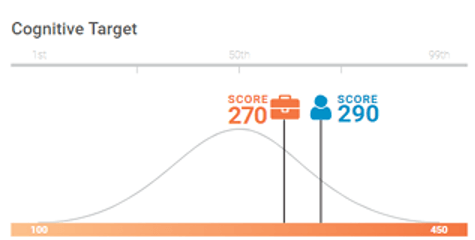
Source.
Practical Example – Step #4:
John’s score of 250 is substantially lower than 310, which will likely yield a low cognitive match score for him.
Step #5 – Lower the number of Questions to Solve
Once you know the score you ACTUALLY need to pass the test, you will be able to substantially increase the time you can allow yourself to solve a question.
In the example below we unpack this with our fictional candidate John’s numbers, effectively increasing his solving time by 40%.
Practical Example – Step #5:
If we go back to the Score Conversion Table, we can see that the score John needs – 310, is 26 correct answers – just 6 more than his original score of 20.
Now, think about it this way.
What if, to begin with, John would have approached his PI test as if the last 20 questions did not exist?
That would give John nearly 25 seconds per question(!) – 40% more than what he thought he had, plus 4 questions to spare.
Since on the PI Cognitive test, the score depends ONLY on the number of correct answers, John has nothing to lose from not even looking at the last 20 questions.
If John combines this with focusing on the types of questions that he, personally, finds easier, he has a very solid strategy for acing this test.
What Is a Good Score on the PI Cognitive Test?
A good score on the PI Cognitive Assessment is your Target Job Score + 30, clear and simple.
What Is the Average Score on the Cognitive Test?
The average score in the PI Cognitive Assessment is 19-20 correct answers, which is equivalent to a PI Scaled Score of 250.
Free Test Answers and Explanations
This section provides full answers and explanations for the PI Cognitive Assessment Full-Length Mock Test.
Question 1
The conclusion is correct.
All Type C clocks are square + Some Type D clocks are the same shape as Type C clocks = Some Type D clocks are square.
Since Square clocks are not valuable, then there are, necessarily, some Type D clocks that are not valuable.
Question 2
The correct answer is 4 – 1/9.
Let’s look at all the answers:
- A: 1/9 < 1/3, so D < A.
- C: 1/3 – 1/9 = 3/9 – 1/9 = 2/9, so D < C.
- D: 2/3 – 1/6 > 1/3 (since 1/3 = 2/3 – 1/3), so D < B.
You see that we try minimizing straightforward calculations in lowest value questions. That is because in the context of the PI cognitive test, it is a waste of time. The best way to quickly solve these questions is by using iterations of comparisons.
If that is unclear, don’t worry, it will become clearer as we solve additional examples.
Question 3
The correct answer is 3.
With every step, two things happen:
- The arrow rotates 90 degrees counterclockwise (When the arrow is horizontal, it is hidden behind the rectangle).
- The black rectangle moves one step to the right.
Question 4
The correct answer is 3.
In both original shapes, as well as in shapes 1,2, and 4, all angles are equal. Only in answer option 3 are angles not all equal.
Question 5
The correct answer is 2.
A jar is the vessel in which jam is stored. A bag is the vessel in which salt is stored.
Question 6
The correct answer is 3.
Idle means “lazy”, which is the opposite of “hard-working”.
Question 7
The correct answer is 3.
The shapes in the sequence gain one side on every step – triangle (3 sides), rectangle (4 sides), pentagon (5 sides). Therefore, the next shape in the sequence should have 6 sides.
Question 8
The correct answer is 2 – 111.
Looking at the sequence of differences:
- 13 – 6 = 7
- 27 – 13 = 14
- 55 – 27 = 28
The difference between every two terms (numbers) starts as 7 and is then multiplied by 2 in each step. Therefore, the difference to the next term should be 28 x 2 = 56.
55 + 56 = 111.
Question 9
The correct answer is 2 – 300.
The problem can be narrowed down to the following equation:
(6,000 x 0.2) / 4 = 300
Question 10
The correct answer is 4.
In the analogous shape, all arrows are rotated 180 degrees relative to the original.
Question 11
The conclusion is correct.
The transition here is pretty straightforward. If both companies A and B produce product X, and Product Z is never produced by companies producing product X, then, necessarily, companies A and B do not produce it.
Question 12
The correct answer is 4 – 36.
The difference between every two terms increases by 1 in every step:
- 14 – 11 = 3
- 18 – 14 = 4
- 23 – 18 = 5
- 29 – 23 = 6
Therefore, the next difference should be 7.
29 + 7 = 36.
Question 13
The correct answer is 1.
The analogous shape is rotated 90 degrees counterclockwise relative to the original.
Question 14
The correct answer is 2.
In the original shapes, as well as in shapes 1, 3, and 4, the shadow of the shape is to the bottom right. Only in shape 2 is it to the top left.
Question 15
The correct answer is 3 – 9.
87 – 13 – 22 – 18 – 25 = 9.
Question 16
The correct answer is 1 – 0.2.
Remember that 0.2 = 1/5.
Let’s look at all the answers:
- B: 0.2 < 0.25 (1/4), so A < B.
- C: 0.5 – 1/5 = 0.4 – 0.2 = 0.3, so A < C.
- D: 1/5 < 3/5, so A < D.
Question 17
The correct answer is 2.
In the analogous shape, the original colors change as follows:
- Black turns white.
- Grey turns black.
- White turns grey.
Question 18
The correct answer is 1 – uncertain.
Definite means “clear”, or “exact”, and therefore the word “uncertain” means the opposite.
Question 19
The correct answer is 2 – hope.
Someone who is weak lacks power, as someone who is despaired lacks hope.
Question 20
The correct answer is 4.
In every step, an additional triangle is added. The direction of the entire shape varies and does not follow any specific pattern. Therefore, the next shape in sequence should contain 5 triangles.
Question 21
The correct answer is 3 – 38.
In this instance, looking at the sequence of differences will not yield any valuable insights. However, we can note that each term equals the sum of the two previous terms, plus 1:
- 10 = 7 + 2 + 1
- 13 = 2 + 10 + 1
- 24 = 10 + 13 + 1
Therefore, the next term equals:
13 + 24 + 1 = 38.
Question 22
The correct answer is 2 – cautious.
‘Reckless’ means irresponsibly daring, careless. Therefore, the word ‘cautious’ means the opposite.
Question 23
The correct answer is 3.
In both original shapes, as well as in shapes 1, 2, and 4, there are 7 blackened tiles. Only in shape 3 there are 8 blackened tiles.
Question 24
The correct answer is 4.
The analogous shape duplicates the original as a mirror image across the horizontal axis. Note that answer option 3, for instance, duplicates a mirror image across the vertical axis, and is therefore wrong.
Question 25
The correct answer is 2 – 7.
This sequence is a simple arithmetic sequence (2, 3, 4, 5, 6) with the addition of the following rule:
- Terms in odd places are negative.
- Terms in even places are positive.
That means that the next term will be positive and is therefore 7.
Question 26
The correct answer is 1 – symphony.
An author writes (or creates) a book, as a composer writes a symphony.
Question 27
The correct answer is 4 – 10/9.
All numbers in the question are improper fractions (fractions that are larger than 1).
- 4/3 is 1 + 1/3
- 7/6 is 1 + 1/6
As such, the number with the lowest value is the number which is closest to 1. Since 1/9 is the smallest fraction of all 4 options (1/3, 1/6, 1/8, 1/9), the number 10/9 is closest to 1.
Question 28
The conclusion is incorrect.
The conclusion is immediately negated by the data in statement 2: Some employees who attend both conferences are in Store 2.
Question 29
The correct answer is 4 – 21.
If 20 plates cost as much as 30 cups, then each plate costs 1.5 times a cup.
Therefore:
14 plates x 1.5 = 21 cups.
Question 30
The conclusion Cannot be determined based on the information available.
While we know that both managers of the main branch AND managers from other branches work in Boston, we know nothing about managers from other branches working in New York.
Question 31
The correct answer is 4 – 19.
The sequence of differences starts with 1 and doubles on every step:
- 4 + 1 = 5
- 5 + 2 = 7
- 7 + 4 = 11
Therefore, the difference between the last term and the next should be 8.
11 + 8 = 19.
Question 32
The correct answer is 2.
In this simple rotation pattern, the shape rotates 90 degrees clockwise on every step.
Question 33
The correct answer is 2 – cheap.
‘Pricey’ means ‘expensive’ or ‘costly’. Therefore, ‘cheap’ is the opposite word.
Question 34
The correct answer is 1 – 20.
On average, it takes 2.5 days to make a car:
15 / 6 = 2.5
Therefore, making 8 cars will take 20 days:
8 x 2.5 = 20.
Question 35
The correct answer is 2.
Both original shapes, as well as in shapes 1, 3, and 4, have 4 sides. Only shape 2 has 5 sides.
Question 36
The correct answer is 3 – 20 hours.
The equation that describes the problem is:
640 / (8 x 4) [the total number of tests (640) divided by the number of tests the now undermanned team performs in an hour (4 tests per employee, times 8 employees)].
640 / 32 = 20.
Question 37
The correct answer is 1 – word.
A word is a collection of letters as a sentence is a collection of words.
Note that the word ‘paragraph’ may fit, but in the opposite direction:
A word is a collection of letters – A paragraph is a collection of sentences.
The opposite direction makes this answer incorrect. It is a common trick that tends to confuse inexperienced test-takers.
Question 38
The correct answer is 1 – 18.
Let’s formulate the equations:
- A = 12 + B
- B = C + 6.
Plugging II) into I) and A = 36:
36 = 12 + C + 6
C = 18.
Question 39
The correct answer is 2 – rascal.
‘Rascal’ means a crook, a dishonest person, which is the opposite of ‘gentleman’.
Question 40
The conclusion is correct.
- The 1st assumption can be simplified to: All managers attended the sales workshop.
- The 2nd assumption can be simplified to: Only outstanding employees attended the sales workshop.
Therefore, all managers are outstanding employees.
Simplifying statements is a very technical process that can greatly help in coming to a quick, intuitive solution that is also correct.
Question 41
The correct answer is 1.
In both original shapes, as well as in shapes 2, 3, and 4, no two adjacent tiles are colored the same.
Question 42
The correct answer is 1.
The two circles move independently, according to the following pattern:
- The black circle moves one step clockwise on every step.
- The grey circle moves one step counterclockwise on every step.
Note that on step 4, both circles are in the same location, so the black circle covers the grey circle (it could have been the other way around, as well).
Question 43
The correct answer is 3 – 1/4 – 1/5.
When we have several options of subtraction drills, the lowest value will be when the minuend is smallest, and subtrahend is greatest. Since ¼ is the smallest of all four minuends, and 1/5 is the greatest of all four subtrahends, this drill will yield the lowest value.
Question 44
The correct answer is 4 – wheat.
Wine is made of grapes as flour is made of wheat.
Question 45
The correct answer is 3 – 36.
In this simple sequence, each term is the square of the respective natural number:
- 1^2 = 1
- 2^2 = 4
- 3^2 = 9
- 4^2 = 16
- 5^2 = 25
Therefore, the next term will be 6^2 = 36.
Question 46
The correct answer is 2 – water.
Wind is moving air, as stream is moving water.
Question 47
The correct answer is 4 – 62.
Looking at the sequence of differences, a very familiar pattern emergers:
- 15 – 12 = 3
- 20 – 15 = 5
- 28 – 20 = 8
- 41 – 28 = 13
These numbers form a Fibonacci sequence (each term is the sum of the previous two). Therefore, the next difference will be the next term in the Fibonacci sequence – 21.
41 + 21 = 62.
Question 48
The correct answer is 3 – elementary.
‘Elementary’ means ‘basic’, ‘simple’, and is therefore the opposite of ‘complex’.
Question 49
The correct answer is 3 – 0.15.
In this question, it is recommended to use the estimation technique, since 1/9 ~ 0.11, which is a number that is easy to work with.
- A: 2/9 ~ 0.22, so C < A.
- B: 2/3 – 4/9 = 6/9 – 4/9 = 2/9 ~ 0.22, so C < B.
- D: 1/3 ~ 0.33, so C < D.
Question 50
The correct answer is 2 – 88.
This is a trick question which attempts to ‘lure’ you into performing some complex calculations, whereas the actual solution is very simple.
To numerically solve this question, the proper calculation is:
((4 x 86) + 96) / 5 *
However, we can look at this in the following way:
- The score of the new student is 96 = 86 + 10.
- As such, when calculating the new average, the additional 10 points over the other students’ average score of 86 will be “evenly distributed” between everyone.
As such, the simpler calculation is:
86 + 10/5 = 86 + 2 = 88 (which is exactly the same result as the exercise marked *).
Preparation
To prepare for the PI Cognitive Assessment, we strongly recommend JobTestPrep’s Preparation Pack.
Below we give all the reasons why this is the best prep option available today.
Full Disclosure: We are affiliated with JobTestPrep. Clicking the links helps us provide you with high-quality, ad-free content.
PI Cognitive Diagnostic Test
The first step in the PI Cognitive Ability Preparation is the diagnostic test. That test will tell you exactly what your weaker areas are, so you can make the most out of the limited time you have to practice.

Authentic Mock Tests
Each practice test on JobTestPrep’s preparation pack accurately simulates the actual PICA:
- Same types of questions
- Time limit
- Level of difficulty

Prepare for your PI Cognitive Assessment Test with JobTestPrep’s PI Cognitive Test Preparation.
What Do You Get?
- PI Cognitive Diagnostic Test with personalized feedback
- 5 Full PI Cognitive Simulations
- 43 PI Cognitive Practice Tests of all question types: Numerical, Verbal, Abstract/Visual
- 11 Study Guides & Video Tutorials
Start Preparing Now
Additional Practice by Topic
According to your results on the Diagnostic Test, you will be able to strengthen your areas of weakness with additional practice drills. Every drill focuses on a specific question type in the PI Cognitive Ability test.

PI Behavioral Prep
As we’ve previously mentioned, the PI Cognitive Ability Test will nearly always come alongside the PI Behavioral Assessment. JobTestPrep is currently the only resource that offers an accurate, comprehensive preparation for the behavioral portion.































